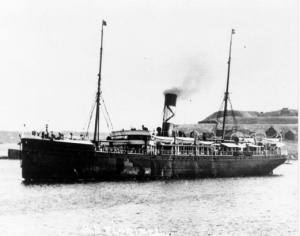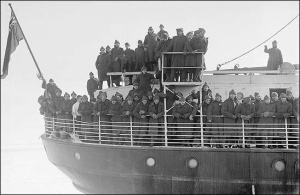In 1909, the Red Cross line, owned by Bowring Brothers commissioned the construction of their flagship vessel, the SS Florizel. She was built to replace the SS Silva, and would act as passenger vessel, troopship, and sealing ship. The Florizel lead a proud career until the fateful night when she sank off the coast of Cappahayden. She has a bunch of stories to tell, but right now, let’s look at her stats.
Ship Stats
Nationality: Newfoundlander
Length: 93.1m
Beam: 13.1m
Weight: 3,081 tonnes
Speed: 12 knots
Capacity: 181 (145 first class, 36 second class)
Year: 1909
Bowring Brothers was established in 1811 as a small commercial business, but over time it grew into one of the most recognized business names in Newfoundland. At the turn of the century, they also got into ship owning, and in 1909 they commissioned the SS Florizel to add to their fleet. On top of becoming their new flagship, she was also one of the first ships in history to be constructed specifically to sail through icy conditions.
During most of the year, the Florizel was a passenger vessel, running from St. John’s, NL to Halifax, NS, and New York, USA. She was considered a luxury vessel for the time, and was a very popular choice for travellers of the time. Then, every spring, she was modified into a sealing vessel and would the carry sealers to the ice fields, usually under the direction of Captain Abram Keane. With Captain Keane, the Florizel broke many records when she was on the sealing grounds. In addition, when the Newfoundland Sealing Disaster happened, she was one of the ships that went to the ice to rescue survivors and and recover the bodies of the victims.
At the beginning of the First World War, the Newfoundland Government made a promise for 500 volunteers to be sent to the cause. On October 3, 1914, these brave men marched down from the training camp at Pleasantville and onto the decks of the Florizel. She brought the first 540 men, called the Blue Puttees, from their homes in Newfoundland across to Europe. She then resumed her passenger runs.
On February 13th, 1918, the Florizel left St. John’s en route for New York via Halifax. Captain William Martin was in charge, and was expecting a routine sail. Even as the weather worsened around the ship, he held her on a steady course towards Halifax. Unknown to him, however, his Chief Engineer, J.V. Reader, had reduced their speed when they had left port. This, combined with the gale force winds, would ultimately lead to her demise.
Hours later, Captain Martin gave the order to steer the ship southward for Halifax, thinking he had already passed the treacherous area of Cape Race. In reality, he still hadn’t even made it to Cape Race, and turned towards the rocks of Horn Head Point. The Florizel was thrust up on the rocks, and began breaking apart. Of the 118 passengers, only 42 would survive.
In light of this tragedy, there was heroism. The captains and crew of the HMS Briton and the HMS Prospero were awarded medals of bravery for their part in the rescue. The surviving passengers took refuge in the Marconi room, and there are stories of passengers encouraging each other to make it through the night.
There was also mourning on the island as the news trickled in. A Peter Pan statue was erected in Bowring Park in memory of Betty Munn, a three year old girl who was traveling to Halifax with her father and lost her young life. Families who were well known lost members – Captain Abram Keane lost his own son, Captain Joseph Keane.
She is a well known name in Newfoundland history, and it’s fairly easy to see why. Being such a versatile ship, she appears in stories of travel, war, and commerce. She is even featured in the work of David Blackwood and other artists. Even now, you can walk down near Cappahayden and see the remains of the Florizel. Most of the remains have been lost in the surf, to vegetation, or to visitors who take pieces as “souvenirs”. She may have lost much of the glory that she once possessed, but her remains still offer a strong reminder of the ship that once was.
That’s all for this Monday. One of my favourite ships is in port this week, and we have more on the way, so this Friday will have some really unique vessels. Have a great week everyone!
Images this week from here, here, and here
I’ve got a Twitter account as well! For history bits, harbour shots, or random facts, follow me @OriginalShipstr


Discussion
No comments yet.